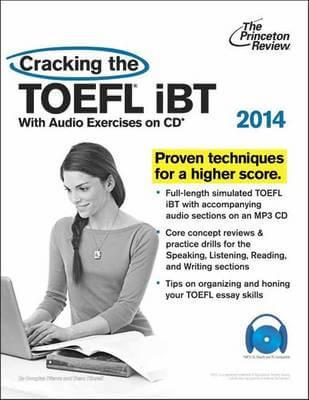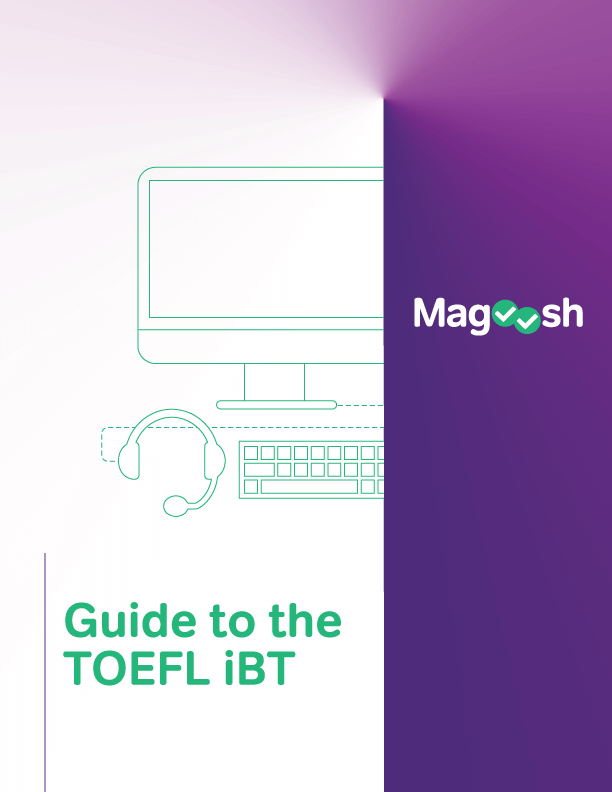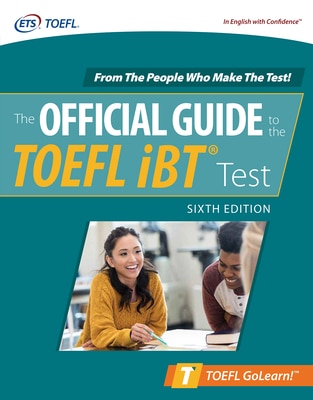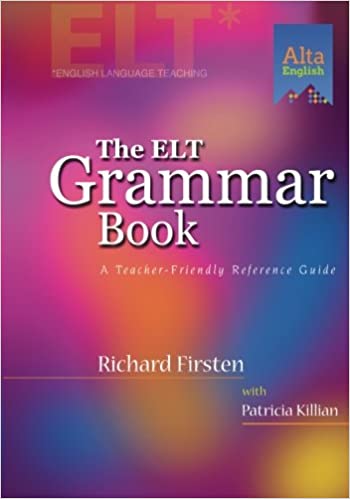(NOTE: The TOEFL books that Magoosh reviews and recommends reflect the older, pre-August 2019 version of the test. As of this writing, there are no TOEFL prep books that reflect the newest version of the test. Fortunately, older-format books are still very useful in prepping for the current TOEFL. For details on this, see Magoosh’s tutorial on using older prep for the 2019 TOEFL.)
 First, let me say that the title of this book really bothers me. The TOEFL cannot be “cracked.” You can prepare for it, yes, but you cannot learn some quick tips and tricks to get a high score. This is a mostly a test of your English experience.
First, let me say that the title of this book really bothers me. The TOEFL cannot be “cracked.” You can prepare for it, yes, but you cannot learn some quick tips and tricks to get a high score. This is a mostly a test of your English experience.
I know, I know—that’s the title of all Princeton Review’s books. That makes it worse, in some ways, because no test is as simple as the title implies. But it’s especially a problem for the TOEFL, in my opinion.
I don’t mean that there are no test-taking strategies or TOEFL-specific tips you should learn. There definitely are some. But to say that they’ll help you to “crack” the test is an exaggeration or, worse, a lie.
But that’s just the title. What about the actual book?
TOEFL Practice Material
Most TOEFL iBT books on the market rely on the number of practice questions and tests to be popular. With that in mind, it’s deeply surprising to me that Princeton Review doesn’t seem to care. In fact, they seem proud of having little practice material: there’s a huge “1” on the front cover. No, not to mean that they’re “number 1,” the best, but to mean that they only have one practice test in the book! For context, the Official Guide includes three practice tests, Cambridge’s book comes with seven practice tests, and Barron’s has five.
But what exactly is there one of? The cover says it’s a “full-length simulated TOEFL iBT test.” Well, that’s almost right. There’s only a paper practice test in the book; there’s no CD, no computer-based practice test. That’s not a very good simulation.
So if you’re a careful buyer, you might be thinking that there’s a lot of other practice material in the book not in the full-length test format. That would be similar to The Complete Guide. And that’s partly true; there are other practice questions in the skill-building and test-strategy sections of the book. But still, there are too few. For example, there are 14 reading passages total in this book. By way of comparison, The Complete Guide has around 40.
Okay, so the quantity isn’t enough. What about the quality of these questions? If the practice is perfect, then it might still be worth the money.
Most of the reading passages and questions are very close to the test, but many are too easy, and a few have clear, serious problems. Some have “wrong” answer choices that are arguably correct. These are especially common in the “Cracking the Reading Section” part of the book. For example, the first example of a vocabulary question looks like this:
1. The word feasibility as used in the passage is closest in meaning to
(A) appropriateness
(B) reasonableness
(C) possibility
(D) viability
Answer choice (C) is too close to the actual definition of the word. Yes, “viability” is a better match, but you could plug in “possibility” to the passage and have basically the same meaning. That’s not very TOEFL-like.
Meanwhile, the recordings for the listening parts are much too fast on average and filled with idioms. The TOEFL does test idioms, and sometimes there are a few fast sentences, but real TOEFL lectures have more small pauses and rephrasing. Cracking the TOEFL iBT’s recordings are too difficult. That does mean they’re pretty good practice—it’s great to train with difficult material—but you’ll also need accurate samples of the test from another book to know what you should expect.
Skill Practice
The most valuable part of Cracking the iBT is in the section named “Core Concepts,” which is what I call skill practice. There are clear, easy to read explanations and helpful exercises for analyzing sentences, paragraphs, texts, and lectures. They focus heavily on understanding relationships between ideas, finding structural keywords, and simplifying complicated English.
To be honest, the advice in “Core Concepts” is often too simplistic. Sometimes the examples have very clear, uncomplicated logical structures, so the exercises aren’t similar to what you will do on test day. But if you are having a lot of trouble understanding the big ideas, and if you get confused and stuck on single, difficult sentences often, the exercises here are great. They are very good beginners material.
That doesn’t take into account grammar and vocabulary improvement. Neither are in this book. There are two pages of grammar, with no exercises. It looks like it was written by a 12-year-old who googled “grammar.” There’s a large table of “commonly misspelled words” that just made me laugh. “Khaki”? Really? I promise that you will never see that word on the TOEFL or have a reason to use it.
Test Strategies and Advice
Despite the big promise that the title makes, this book has very little advice that’s specific to the TOEFL. The author is focused on general test-taking strategies and seems not to know about how the TOEFL is different.
For example, the book focuses heavily on process of elimination. In both reading and listening, it recommends you look at every answer choice and try to find how or why it’s wrong. This is sometimes useful on the TOEFL, but it’s often unnecessary. If you understand the reading or recording, then the correct answer will be the only one that gives the same information.
On the GRE, GMAT, or SAT, the wrong answers have logical mistakes. They assume information, make extreme statements, or draw connections between unrelated facts. In contrast, on the TOEFL, the wrong answers are usually wrong because of a language problem. The focus of a sentence is wrong, for instance, or the direction of an action is reversed.
The Princeton Review describes wrong answers on TOEFL in the same way they describe wrong answers on the other tests, and that’s just wrong.
There’s a lot of other bad advice, too. My favorite is “skim, don’t read.” This is a common mistake in TOEFL books. Trying not to read the passage will simply confuse you. It’s absolutely necessary to read the whole passage. Yes, you’ll need to move quickly past difficult sentences that you don’t understand 100%, but you should read them and try to understand them. Skipping any information is a bad idea.
The advice to skim is based on the idea that TOEFL texts and recordings are very, very structured. On the one hand, it’s true that structure is very important. On the other hand, it’s not so simple, so clear as Cracking the TOEFL says. The big picture structures of the texts, lectures, and conversations will often be a little bit unclear, because the topic changes a bit. There is not a “intro, body, conclusion” structure all the time, even though this book says there is. Interestingly, the practice passages and recordings are pretty similar to the structures of real TOEFL material. But their strategies don’t fit their samples.
On the same note, the writing guide directs you to an overly simple essay. For a low-level student, this isn’t bad, but following their advice if you’re an advanced student (aiming for 100+) won’t help you any.
And finally, there’s almost nothing about the clock in this book. Timing is extremely important on the TOEFL—it’s one of the biggest problems students face. But Cracking the TOEFL mostly ignores it. In fact, they even tell you that the reading section will be 60 or 100 minutes with “three or four” passages. That’s close, but not true, and it makes a very big difference. You’ll have 60, 80, or 100 minutes for three, four, or five passages; you get 20 minutes per passage. It’s not possible to have 100 minutes for four passages. It seems like the author had no idea about how important timing is.
Explanations
Besides the good skill-building exercises, this book has one other strong point: it’s written in clear, casual, understandable language. The explanations of ideas and answers are well written.
And there are explanations for everything in the book—no answers standing by themselves without details. That’s fantastic. Some of the explanations are too short/uninformative (e.g. “Answer D is obviously incorrect”) but it’s better than many books offer.
But that’s really just true of the reading and listening sections. The writing sections have sample essays (very important!), which makes me happy, but they’re very badly graded. What should be a 5, the highest grade, might be graded as a 4. And worse, what should be a 3 is graded as a 1. Again, this seems to be because the author is confusing the TOEFL with other tests. Although structure and message are important for the TOEFL, language use—correct grammar and high-level vocabulary—is more important. An essay that doesn’t choose a side does not necessarily get a bad grade.
It’s good that they want you to focus on structuring your essay and making your message clear, but their scoring is not like the real TOEFL.
And what about the speaking tasks? Sadly, there are no speaking samples. So that doesn’t help much.
Report Card:
Authenticity of practice material: C+
Amount of practice material: D-
Quality of explanations: B-
Skill building material: B+
Test strategy and advice: D
The Final Word
If I recommended this book to anybody, it would be to a low-level student who’s very scared of the length and language level of the reading passage, and it would be just for the “Core Concepts” section of the book.
But really, I wouldn’t recommend it for anything else.






Leave a Reply